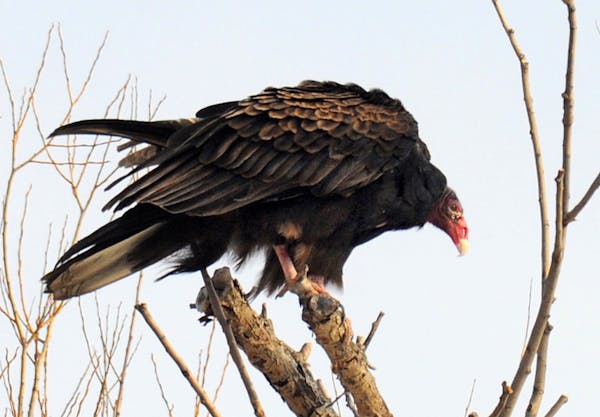Turkey vultures never seem to hurry. They glide silently above us, drawing circles in the air, calligraphers with quill pens. They tip and turn up there in the wind, rarely flapping those long willowy wings. They can be among the early returning migrants. My seasonal first this spring was March 15.
And, why should vultures hurry? They're scavengers. The objects of their culinary affection are dead. These birds need not rush to the table.
You probably have seen a turkey vulture. They are migrants in spring and fall and summer residents throughout the state, moving in and out at about the time of the equinoxes. Their coal-dark silhouette against a bright sky is not uncommon. Perhaps you thought the bird was an eagle or hawk.
How do you know the difference? Eagles glide with wings held flat, a straight line across the back from wingtip to wingtip. Turkey vultures soar with wingtips higher. That silhouette makes a distinctive shallow "V": V for vulture. The tipping motion you see, the rocking side to side, also is characteristic of their flight.
A vulture's face seems to be without flesh, a skull protruding from a cloak of feathers. In flight, the featherless head appears small, often tucked back into that ruff, difficult to see. The bird will pull its bare head and neck into the ruff for warmth, or extend its head when cooling is more comfortable.
I have rarely found vultures as this bird is shown, grounded, perched in an idle moment. One summer near Elk River I did come upon a dozen or so loafing one morning in a gravel pit, probably waiting for the air to warm and thermal currents to form. They allowed me to approach to perhaps 60 or 70 feet before taking wing.
The birds leaned into the air when I moved too close. Not a sound came from them, just the whoosh of thick wingbeats. They pumped hard to clear the embankments and climb into a gray sky.
The word vulture comes from the old Latin vulturus, meaning to tear. That's how the bird gets food: It tears bits from the carcasses it finds. It has weak foot muscles; it cannot grasp well enough to capture and kill prey. It also lacks the strength and physical equipment to open a fresh carcass itself.
Turkey vultures are opportunistic feeders on carrion, taking what nature provides. In a Pennsylvania study, dead domestic livestock was found to comprise almost 70% of the vultures' diet. The birds often can be found at roadsides, hunched over the carcass of a car-killed deer.
They'll eat small mammals, insects, frogs, shrimp, fish and an occasional bird. They'll also eat vegetation, if carrion can't be found.
The dead animals a vulture might eat can contain organisms that could cause serious disease in other diners. The vulture's gut destroys these organisms. The vulture removes infected material from the landscape, preventing other animals from becoming ill or spreading disease.
Turkey vultures are believed to mate for life. They nest in solitary places, strongly preferring privacy. They seek cliffs, rocky crevices, caves, hollow trees or logs or abandoned buildings.
Vultures find most of their food by their sense of smell. They can detect odors measured in parts per trillion. They have large nostrils (called nares in birds).
Turkey vultures were named by someone who thought the bird resembled a wild turkey (at a distance, we presume). Their North American family includes black vultures, a species found in southeastern states, and the endangered California condor.
Lifelong birder Jim Williams can be reached at woodduck38@gmail.com.
Singing, ceremonies and straw hats: Olympics opening ceremony in Tahiti centers Polynesian culture

Three 101-year-old friends recall fond memories in 1940s Alexandria
Celine Dion makes musical comeback at Paris Olympics with Eiffel Tower serenade



